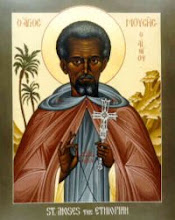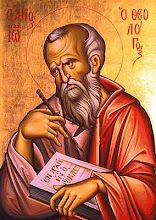Blog Archive
-
▼
2010
(300)
-
▼
June
(26)
- Greek Orthodox TV
- A Defense of the Holy Icons!
- Baptismal Regeneration & Church Fathers
- Class Introduction - An Orthodox Appraisal of the ...
- Is it necessary that we accept the free Gift of Sa...
- Wednesday Classes at St. Elijah
- Fr. John Brun at St. Elijah - Our Bridge...From th...
- The Study of Icons Seminar at St. Elijah
- Perry tackles the Iconoclasm issue
- St. Elijah Presents Fr. Daniel
- Mysteries of the Jesus Prayer
- Vatican: Oldest known images of apostles Andrew an...
- From Empire to Empire
- The First Millenium of Christianity
- Nun Katherine Weston
- eshon Burgundy- "The Nikon Flash"
- Spacing
- The Not James White’s Blog
- A new template.....maybe
- Tertullian & Sola Scriptura by David W
- Ecclesial Deism by the Roman Catholic Bryan Cross
- Fr. Deacon Nathaniel
- Mr. Webster's understanding that the Fathers appea...
- A short History of the Orthodox Church
- Fr. Deacon Nathaniel
- Tertullian and Tradition/Observances/Customs not m...
-
▼
June
(26)
Saint Moses the Black

Saint Moses the Black
Ecumenical Councils
Popular Posts
-
As seen from Theologica : (I am putting this on my blog because it took me a few hours to write. I only used his initials instead of his ful...
-
I could be wrong, but I believe this was a few weeks before the recent Egyptian protests.
-
Deuteronomy 32:22 "For a fire burns away of my rage; it shall be burned unto lower Hades ;" JONAH 2:2 "From out of the belly ...
-
It came by accident, well, nothing really happens by accident, but it all started in undergrad at Tuskegee University in Tuskegee Alabama. I...
-
PIZZA MAN made a post about "Theology and the Slave Trade" . I showed this to HCR and the thread I made was eventually deleted. Th...
Labels
- about me (54)
- African American (33)
- Albert (5)
- ancestral sin (5)
- Ancient Christianity Conference (31)
- ancient heresies (23)
- ancientfaithradio (124)
- Archeology (11)
- Arminianism (32)
- Atheism (26)
- Atonement (18)
- Audio Sermons (10)
- Augustinianism (14)
- Baptism (11)
- Bible study (12)
- Book reviews (7)
- books (69)
- brotherhood of saint moses (25)
- calamity (2)
- Calvinism (69)
- charity (3)
- Christmass (10)
- Christology (1)
- Church Calendar (5)
- church fathers (60)
- church history (120)
- Confession (1)
- conspiracy theories (4)
- conversion stories (42)
- creationism (13)
- David (7)
- debates (14)
- determinism (1)
- Divine Energies/grace (15)
- Divine Energiesgrace (1)
- Divine Liturgy (5)
- Dr. Jeannie Constantinou (43)
- Eastern Orthodoxy (254)
- ecclesiology (3)
- Economics (2)
- Ecumenical councils (8)
- election (6)
- eschatology (22)
- Eucharist (7)
- Eugenics (7)
- Evangelism (1)
- fasting (8)
- free will (27)
- Ft. Thomas Hopko (43)
- fullpreterism (5)
- hiphop music (31)
- Icons (15)
- Incarnation (1)
- interest (3)
- Isa Almisry (1)
- Jesus (18)
- Kabane52 (1)
- Kallistos Ware (8)
- Learning Greek (5)
- Lectures (2)
- Lutheranism (1)
- Maximus Scott (2)
- Monasticism (15)
- Neopaganism (1)
- News (6)
- Oriental Orthodox (16)
- Orthodox Apologetics (22)
- Orthodox education (12)
- Orthodox Podcasts (30)
- Orthodox videos (67)
- Orthros/Matins (1)
- Panentheism (4)
- Parish life (34)
- pascha (9)
- Pascha/Easter (17)
- Patristics (7)
- perseverance (7)
- phatcatholic (6)
- politics (51)
- Prayer (32)
- prevenient grace (6)
- Protestantism (135)
- quotes (5)
- rapture (2)
- resources (8)
- resurrection of the dead (5)
- RocknRoll (4)
- Roman Catholicism (36)
- Romans 9 (10)
- sacramental theology (6)
- Sacred Music (10)
- scripture (71)
- scripture exposition/Interpretation (95)
- semi-pelagianism (9)
- Septuagint (12)
- Sola Scriptura (5)
- Theological vocabulary (6)
- Theotokos (4)
- thoughts (157)
- Tony Allen (9)
- tradition (35)
- Trinity (9)
- Western Rite (1)
Saint John the Theologian

Saint John the Theologian
Facebook Badge
Followers
Total Pageviews
Protestant & Catholic Rapsites I post on
About Me
Wednesday, June 30, 2010
A Defense of the Holy Icons!
As seen from Orthodox Apologetics by David
To read the rest please visit Orthodox Apologetics
Part 2
To read the rest please visit Orthodox Apologetics
ICXC NIKA
Quote:
"One of the most common criticisms that Protestants express against Orthodox Christianity is the prominent place of iconography, a uniquely Orthodox Christian figurative art form, in the Church. That Orthodox Christians give a very special place to the Holy Icons is hard to miss. Our churches, homes, and even places of business are filled with them, often outside as well as in. Upon entering a church and before prayers at home, Orthodox Christians generally perform bows from the waist1 and kiss the icons in reverence. During the worship services in an Orthodox Church, the Priest frequently incenses the icons and the worshipers frequently bow and even prostrate toward them. On various feast days throughout the year,2 icons of Christ, of the Theotokos,3 and of various Saints and Angels are raised high and processed in and around churches and streets. And we do, after all, refer to them as the “Holy Icons.”
For Orthodox Christians, icons are an intrinsic aspect of our spirituality and of our everyday lives. We use them for prayer, as gifts, as decoration, as jewelry, and as ever-present reminders of our loved ones and the love and inspiration they offer. We even believe that God can and does work miracles through them. There are many icons referred to as “wonder-working” or “myrrh-streaming” which Orthodox believers bear a special reverence for, accepting that through these particular icons God has done a special act for man.4 Some of these icons are even on the calendar of feast days we celebrate.5"
To read the rest please visit Orthodox Apologetics
Part 2
Quote:
"An obvious and important question to ask when examining the validity of the presence and veneration of the Holy Icons in the churches today is whether or not the earliest Christians, roughly those of the first five hundred years of the Church, used iconography and, if so, how they used it. The faith and practice of these earliest Christians is supremely important in deciding correct faith and practice of Christians today as these early Christians lived the closest in time, place, and culture to the Apostles and other first century followers of Christ. Many of the Christians who lived during this period were members of churches which had been directly founded by Apostles and lived in cities mentioned in the Bible. In addition, very importantly, most of the Christians of this period spoke the ancient Greek of the New Testament as their own native language. Recognizing the importance and authority of the early Church, John Calvin wrote:
If the authority of the ancient church moves us in any way, we will recall that for about five hundred years, during which religion was still flourishing, and a pure doctrine thriving, Christian Churches were commonly empty of images. Thus, it was when the purity of the ministry had somewhat degenerated that they were first introduced for the adornment of churches.12
Until fairly recently, Calvin's words here were the common assumption of both Protestants and historians of early Christianity. It was widely believed and taught that the churches of the first several hundred years were largely imageless and that Christians themselves were generally hostile to figurative art, rejecting it as an idolatrous pagan practice. This assumption was largely based on a dearth of archaeological evidence and on a false assumption of Jewish iconophobia coupled with erroneous prooftexting of various early Christian writers' criticisms of the idols of the pagans.
All three bases of the theory of early Christian hostility toward images have been dismantled by the introduction of new evidence throughout the 20th century, and more evidence continues to be uncovered today through archaeological exploration.14 The hole that once existed in physical evidence of the worship of ancient Christians and Jews has now been filled with numerous discoveries throughout the Middle East, Southern and Eastern Europe, and North Africa."
To read the rest please visit Orthodox Apologetics
ICXC NIKA
Subscribe to:
Post Comments (Atom)
About Me
Blogs: Eastern Orthodox
-
-
-
-
-
-
-
It’s Time to Say Goodbye1 year ago
-
-
-
Orthodox Life13 years ago
-
-
Resurrection Sunday 20243 days ago
-
-
-
-
The end of Pious Fabrications10 years ago
-
The Holy Fathers on Witchcraft4 months ago
-
Bending Toward Bethlehem4 months ago
Blogs: Oriental Orthodox
-
-
The Importance of The Passion Week8 years ago
Blogs: Roman Catholic
-
-
-
-
-
-
A Brief Update10 years ago
-
-
-
My Sister's New Blog13 years ago
-
Blogs: Anglo-Catholic/ACNA
-
ROGATION SUNDAY Easter V 20242 days ago
-
-
-
-
Blogs: Lutheran Protestant
Blogs: Mostly Arminian Protestant
-
Book Review: Grace for All8 years ago
-
-
Design Interior Rumah Type 36/725 years ago
-
Christian Rappers and Collaborations12 years ago
-
-
-
-
-
-
-
When Truth is Partial: Horses Like Apples2 years ago
-
-
-
NOT Independence Sunday14 years ago
-
Picture of Calvinist Ship1 year ago
Blogs: Reformed Protestant
-
-
-
-
This Blog Has Moved!!!9 years ago
-
-
John Calvin And The Use Of Icons14 years ago
-
-







0 comments: